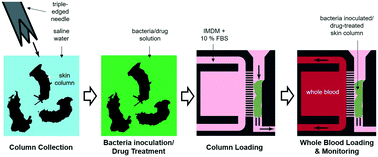A microscale, full-thickness, human skin on a chip assay simulating neutrophil responses to skin infection and antibiotic treatments†
Abstract
Human skin models are essential for understanding dermatological diseases and testing new treatment strategies. The use of skin biopsies ex vivo is the most accurate model. However, their use is expensive and exposes the donor to pain and scarring. While bioengineered skin samples provide a cheaper alternative, they have limitations due to their simple structure and functionality compared to human skin. Here, we present a skin-on-a-chip device designed to study neutrophil responses to Staphylococcus aureus skin infections. We integrate human skin microcolumns, which have a cross-section that is ∼100 times smaller than traditional skin biopsies, are full-thickness, and are collected using minimally invasive skin sampling techniques. We use human neutrophils directly from one drop of blood, without the need for blood separation. Using the skin-on-a-chip device with skin and blood samples from healthy donors, we show that the neutrophil responses correlate with the bacteria-load in the skin. A pre-incubation step increases the number of migrating neutrophils in response to a low concentration of bacteria. Antibiotic treatment of S. aureus-infected skin samples reduces the number of neutrophils migrating towards the skin. Overall, we validate a skin on a chip model that enables the study of neutrophil migration to the skin in the presence of microbes and following the administration of antibiotics, two situations relevant to clinical cases of human skin and soft tissue infections.



 Please wait while we load your content...
Please wait while we load your content...